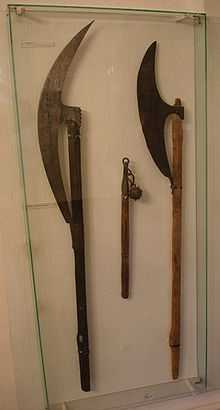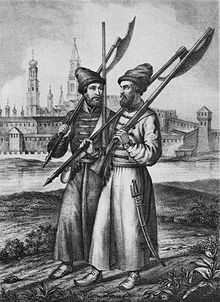Bardiche

A bardiche /bɑrˈdiːʃ/ or berdiche ("long poleaxe") is a type of glaive polearm known in the 16th and 17th centuries in Eastern Europe. Ultimately a descendant of the medieval sparth (Danish axe), the bardiche proper appears after 1500, but there are numerous medieval manuscripts that depict very similar weapons beginning ca. 1250. The bardiche differs from the halberd in having neither a hook at the back nor a spear point at the top.[1]
Use of bardiches started in early 15th century Russia (some sources name the late 14th century), and in Scandinavia in the late 15th century. In the 16th century the bardiche became a weapon associated with streltsy (Russian guardsmen armed with firearms).[2]
Description
The blade varied greatly in shape, but was most often a long, cleaver type blade. The distinction was in how the blade was attached to the pole. The bardiche blade was attached to the pole either via two sockets (one at the top of the pole and one lower, at the base of the blade) or one socket at the top and one surface mount at the base, effectively mounting the heavy blade to the wooden shaft. This construction is also seen in Scottish polearms, such as the Lochaber axe and Jeddart staff, and bardiches are known to have been imported into Scotland in the 16th and 17th centuries[3] Depending on the design of the particular weapons in question, at times a bardiche may greatly resemble a voulge.
While the blade was often very long for an axe (usually exceeding 2 feet (60 cm)) the shaft was one of the shortest of all polearms; rarely did it exceed 5 feet (1.5 m) in length. It relied more on the weight of its heavy blade to do the damage than a swing from a long pole. This makes the bardiche more similar to the Danish axe, in some respects, than to a true polearm.
Use

In Russia and in Poland this weapon was used to rest handguns upon when firing. It was standard equipment for the Streltsy (literally "shooters") corps (foot, mounted and dragoons) and also for the Polish infantry (shorter version invented by King Jan III Sobieski).[4] Another use of the bardiche was for execution.
References
- ↑ R. E. Oakeshott, European weapons and armour: From the Renaissance to the industrial revolution (1980), 48-49.
- ↑ Кирпичников А. Н., «Военное дело на Руси в XIII—XV вв.» Л., 1976 / Kirpichnikov A.N. Warfare in Russia in the 13th-15th centuries. Leningrad, 1976. (Russian)
- ↑ Caldwell, David (1981). "Some Notes on Scottish Axes and Long Shafted Weapons". In Caldwell, David. Scottish Weapons and Fortifications 1100-1800. Edinburgh: John Donald. pp. 253–314. ISBN 0-85976-047-2.
- ↑ Besala, Jerzy (1983). Wielcy Hetmani Rzeczypospolitej (in Polish). Warszawa: Krajowa Agencja Wydawnicza. p. 72. ISBN 83-03-00160-4.